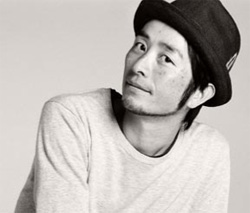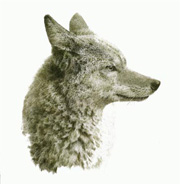Home > Highlighting JAPAN > Highlighting Japan AUGUST 2011 > Points and Lines
Highlighting JAPAN
COVER STORY: The Colors of Cool
Points and Lines
Yokohama Triennale 2011 is being held in Yokohama, Kanagawa Prefecture, from August 6 to November 6, bringing together works by contemporary artists from Japan and around the world. The Japan Journal's Osamu Sawaji talked to one of the artists exhibiting at this year's event, painter Manabu Ikeda.

Manabu Ikeda
Credit: YUKIKO ONLEY
Where do you find your inspiration for your pictures?
Manabu Ikeda: The themes and subject matter of my pictures are mostly an expression of my own experience, but recently I incorporate ideas from TV, books, or photographs, which I reconstruct inside my own head. It depends on the piece. With some I decide on the theme first and then draw, but with many of my works I just let the ideas take their course and proliferate. My bigger works tend to fall into the latter category.
However, even though I let them take their course, I want the picture to include the things I am interested in, so I include things like the relationship between man and nature in present-day society, and my aesthetic sense as a Japanese person, while at the same time trying not to become too serious.
You now live in Vancouver under the Overseas Study Program for Artists run by the Agency for Cultural Affairs. Why did you choose Canada as your destination?
The theme of my pictures is the relationship between man and nature, and I had an image of Vancouver as a city where the city and nature coexist in harmony. I chose this place out of the desire to see with my own eyes the points of fusion between the two, how people confront nature, and so forth, and to use this in my works.

"Canis latrans," by Manabu Ikeda (2008); pen and acrylic ink on paper (19.3 x 16.2 cm). This work is being exhibited at Yokohama Triennale 2011.
Ikeda creates his works with a mapping pen to render a level of detail that is unique. With this technique he can produce only ten square centimeters in an eight-hour day.
Credit: ©IKEDA MANABU/ COURTESY OF MIZUMA ART GALLERY
The work you exhibited in "Bye Bye Kitty!!!" held in March by the Japan Society of New York made the headlines in the New York Times. How are your works interpreted outside Japan?
People overseas may regard my choice of motifs, my technique, and so on as "typically Japanese" or "typically Asian." I think people overseas tend to ask me more about the hidden meaning behind the themes or motifs of my pictures compared with people in Japan. But the way people look when they are viewing my pictures is the same everywhere. When I see them enjoying my pictures, bringing their faces closer and pointing to various parts, I think that all human beings are fundamentally the same.
How did you feel when you heard the news about the Great East Japan Earthquake? Has the earthquake affected you as an artist?
I was in Canada, so I learned of it from a friend's e-mail. When I saw the images on the TV, I thought it was a country somewhere in Asia, but when I saw the word "Japan" I was barely able to move from the shock. Some part of me had thought that even if a tsunami hit, it would not have this effect on a developed country like Japan. So much so that from where I was watching overseas I genuinely thought that the epicenter was not Tohoku but Japan, and that the whole of Japan would be submerged in water. Seeing Japanese signs and rice paddies, houses with tiled roofs and cars, the familiar landscape of my native country being swallowed up in the tsunami was soul-crushing.
And I remember feeling so guilty that I alone was overseas and out of danger.
Having always depicted the relationship between man and nature, this earthquake became a major proposition for me. From now on, I want to paint pictures that will raise the issue of what we should do in respect of the environment, nuclear energy, and radiation, but that will also in some way empower.
What works do you plan to exhibit at Yokohama Triennale 2011?
The works I am exhibiting at the Yokohama Triennale diverge slightly from my usual style, consisting of life-like pen drawings of real animals and drawings of imaginary organisms produced in the same way—a total of thirty pieces. By displaying them in rows like specimens, the boundary between fantasy and reality is blurred, and offers the viewer the sensation of wandering back and forth inside a magical illustrated reference book.
| Yokohama Triennale 2011 (August 6–November 6) Yokohama Triennnale is a tri-annual international exhibition of contemporary art that was inaugurated in 2001, and subsequently held in 2005 and 2008, attracting approximately 1 million visitors to date. Under the theme of "OUR MAGIC HOUR," Yokohama Triennale 2011 will be held at two main venues—the Yokohama Museum of Art and Waterfront Warehouse (BankART Studio NYK)—and focus on works that allude to the magical mysterious powers in our daily lives and world as well as those that refer to mythology, myths and legend. Access Yokohama Museum of Art: 3-4-1 Minato Mirai, Nishi Ward, Yokohama. Close to Minato Mirai and Sakuragicho Stations. 30 minutes from Tokyo Station on JR lines. Waterfront Warehouse: 3-9 Kaigandori, Naka Ward, Yokohama. Close to Bashamichi Station. 30 minutes from Tokyo Station on JR and Minatomirai lines. |
© 2009 Cabinet Office, Government of Japan






